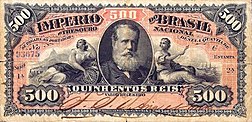
Back Real (antigua moneda brasileña) Spanish Real Brasil (lama) ID Real (antiga moeda brasileira) Portuguese Бразильский реал (старый) Russian Бразильський реал (старий) Ukrainian
This article needs additional citations for verification. (October 2021) |
| real (Portuguese) | |
|---|---|
 500 réis Treasury note from 1880 | |
| Unit | |
| Plural | réis |
| Symbol | Rs$ |
| Denominations | |
| Superunit | |
| 1000 | mil réis |
| 1,000,000 | conto de réis |
| Banknotes | |
| Freq. used | 500, 1$000, 2$000, 5$000, 10$000, 20$000, 30$000, 50$000, 100$000, 200$000, 500$000 |
| Rarely used | 1:000$000 (conto de réis) |
| Coins | |
| Freq. used | 20, 50, 100, 200, 400, 1$000, 2$000 |
| Rarely used | 40, 80, 300, 320, 960 |
| Demographics | |
| Date of withdrawal | 1 November 1942[1] |
| Replaced by | Cruzeiro (1st version) |
| User(s) | Empire of Brazil United States of Brazil (First Brazilian Republic and Vargas Dictatorship) |
| Issuance | |
| Central bank | Thesouro Nacional |
| Printer | American Bank Note Company |
| Mint | Casa da Moeda do Brasil |
| Valuation | |
| Inflation | 1.5% (1880) 41% (1890) 13% (1900) 6% (1930) |
| Source | Consumer price index |
| This infobox shows the latest status before this currency was rendered obsolete. | |
The first official currency of Brazil was the real (pronounced [ʁeˈaw]; pl. réis), with the symbol Rs$. As the currency of the Portuguese empire, it was in use in Brazil from the earliest days of the colonial period, and remained in use until 1942, when it was replaced by the cruzeiro.
The name "real" was resurrected in 1994 for the new currency unit (but with the new plural form "reais"). This currency is still in use. One modern real is equivalent to 2.75 × 1018 (2.75 quintillion) of the old réis.
The name comes from the Portuguese word real (in the sense of "royal" or "regal") and was borrowed from a Portuguese currency previously used in Brazil.[citation needed]
The dollar-like sign in the currency's symbol (and in the symbols of all other Brazilian currencies), called cifrão in Portuguese, was always written with two vertical strokes (![]() ) rather than one.
) rather than one.
- ^ "Decreto-lei Nº 4.791" (in Brazilian Portuguese). Câmara dos Deputados. 5 October 1942. Retrieved 5 July 2021.
© MMXXIII Rich X Search. We shall prevail. All rights reserved. Rich X Search